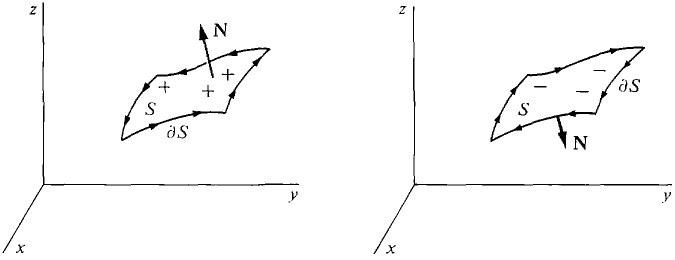| The ebook Elementary Calculus is based on material originally written by H.J. Keisler. For more information please read the copyright pages. |

|

Home  Vector Calculus Vector Calculus  Theorems of Stokes and Gauss Theorems of Stokes and Gauss  Stokes' Theorem Stokes' Theorem |
|






|
|
Stokes' Theorem
Stokes' Theorem relates a surface integral over S to a line integral over the boundary of S. It corresponds to Green's Theorem in the form
Let S be an oriented surface over a region D. The boundary of S, ∂S, is the simple closed space curve whose direction depends on the orientation of S as shown in Figure 13.6.1. The notation
denotes the line integral around ∂S in the direction determined by the orientation of S.
Figure 13.6.1 The Boundary of S STOKES' THEOREM Given a vector field F(x, y, z) on an oriented surface S,
(See Figure 13.6.2.)
Figure 13.6.2 To put this equation in scalar form, let F = Pi + Qj + Rk, curl F = Hi + Lj + Mk. Then F · T ds = P dx + Q dy + R dz, and if S is oriented with the top side positive,
Thus Stokes' Theorem has the scalar form
Stokes' Theorem has two corollaries which are analogous to the Path Independence Theorem.
|
|
Home  Vector Calculus Vector Calculus  Theorems of Stokes and Gauss Theorems of Stokes and Gauss  Stokes' Theorem Stokes' Theorem |
|
Last Update: 2006-11-22








